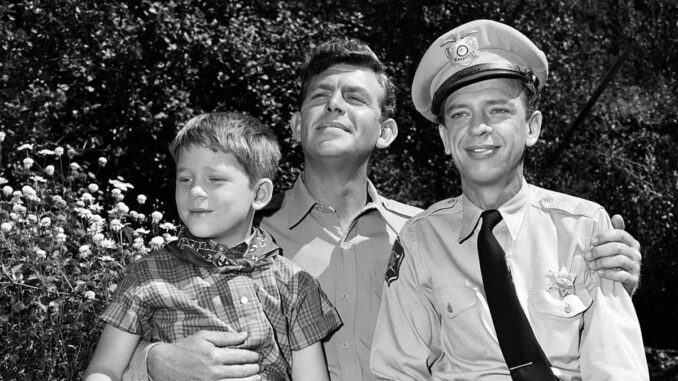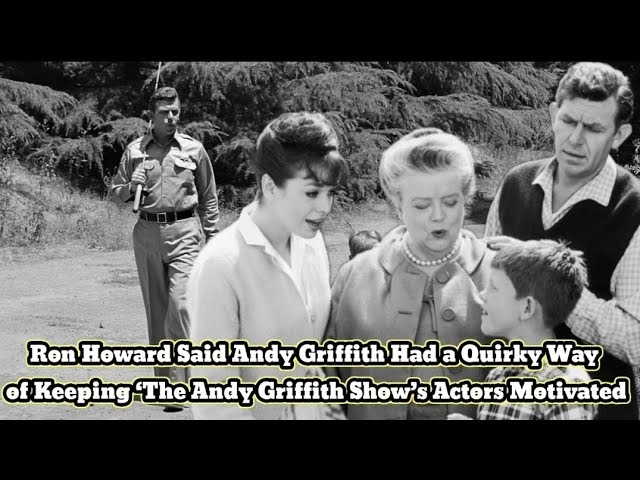
Introduction: A Mayberry Mystery Finally Revealed
Ever wondered how The Andy Griffith Show maintained its charm, consistency, and spirited cast performances throughout its eight seasons? While much of the credit goes to the brilliant writing and talented actors, there was one unusual trick up Andy Griffith’s sleeve that helped keep his co-stars on their toes—and laughing.
Ron Howard, who played the beloved Opie Taylor, recently opened up about Griffith’s quirky, yet effective way of keeping the crew and actors motivated. Let’s dig into the secrets behind the scenes in Mayberry and discover how Andy kept the magic alive.
The Heartbeat of Mayberry: Andy Griffith’s Role Behind the Scenes
Not Just the Star—Andy Was the Soul of the Show
Andy Griffith wasn’t just playing the sheriff of Mayberry—he was the leader of the set. While his character was calm, wise, and easygoing, the real Andy had a sharp wit and a surprising way of making sure his cast stayed alert and in good spirits.
A Mentor to Many, Especially Young Ron Howard
Ron Howard, who started on the show at just six years old, often credits Andy as a major influence on his career. But one thing that stood out to Ron was Andy’s offbeat, almost mischievous method of motivating people.
What Was Andy Griffith’s “Quirky” Method?
Practical Jokes Were Part of the Routine
According to Howard, Andy had a playful side that showed up frequently on set. He’d pull light-hearted pranks—not to embarrass anyone—but to inject energy into a long filming day.
Making People Laugh Was the Goal
It wasn’t about scaring anyone or causing chaos. It was about laughter. If someone was having an off day or the scene wasn’t clicking, Andy might launch into an impromptu impression or start telling an exaggerated story—usually with a thick Southern twang.
The Southern Storyteller That Inspired the Cast
Andy’s Tall Tales Became Legendary
Griffith would sometimes invent completely wild, obviously fake stories and tell them with complete sincerity, just to watch the crew try to keep a straight face. These stories weren’t written down anywhere. They were spontaneous—and they worked.
A Way to Break the Tension
On a show that thrived on warmth and community, Andy understood that tension killed creativity. His quirky antics served as a reset button, lifting moods and re-centering focus.

A Young Ron Howard Was All Ears
Observing the Power of Leadership Through Humor
As a child actor, Ron Howard saw how laughter could control a room. Watching Andy light up the set with his charm taught Ron about leadership, timing, and how to read people—a lesson he’d carry into his own directing career.
Andy as a Role Model for Ron’s Career
Ron would later say that Andy showed him how to be a professional and have fun doing it. That blend of discipline and playfulness was key in both acting and directing.
Not Every Actor Could Keep a Straight Face
Don Knotts Was Often the Target
Don Knotts, the comedic genius behind Barney Fife, was notorious for breaking character when Andy launched into a bit. Griffith loved getting Don to crack during rehearsals—it was all in good fun, and it reminded everyone that even a polished show needs a dose of chaos.
Moments That Never Made the Final Cut
Many of these laugh-out-loud moments were never captured on camera—or were cut from the final episode. But the cast and crew still recall them as some of their favorite memories.
Why This Motivational Style Worked So Well
Humor Builds Bonds
Andy wasn’t using humor just for fun—it was strategic. Laughter is a bonding tool, and on a set that depended on trust and chemistry, it was essential.
Breaking Routine, But Never the Rhythm
Instead of sticking to a rigid schedule, Andy’s occasional bursts of silliness gave the crew small breaks without stopping progress. It kept people sharp without exhausting them.
Other Cast Members Appreciated It Too
Frances Bavier Wasn’t Always on Board—But She Understood It
Frances Bavier, who played Aunt Bee, had a more traditional acting background. While she didn’t always get Andy’s humor, even she acknowledged that his playful energy helped the younger actors stay upbeat.
George Lindsey and Howard McNear Were Game for the Gags
Goober and Floyd weren’t just funny on-screen—they were in on the fun behind the scenes too. Andy’s sense of humor set the tone for everyone, and it showed in their performances.
Lessons from Mayberry for Today’s Workplaces
Motivation Doesn’t Always Have to Be Serious
Andy Griffith’s approach proves that keeping people engaged doesn’t require intense pressure or forced positivity. Sometimes, it just takes a good joke.
Humor Can Be a Leadership Superpower
Leaders today can take a page from Andy’s book: lighten the mood, show some personality, and you’ll bring out the best in your team.
Andy Griffith’s Method Left a Legacy
The Energy on Set Was Part of the Show’s Magic
It wasn’t just what was written in the script. The unspoken atmosphere—created in part by Andy’s quirky motivators—made The Andy Griffith Show something truly special.
Ron Howard Still Uses Those Lessons Today
As a successful director and producer, Ron Howard carries Andy’s legacy forward. Whether working on a Hollywood blockbuster or a small indie project, he understands the value of levity and human connection on set.
Conclusion: Andy Griffith’s Humor Was His Hidden Superpower
While millions of fans remember Andy Griffith for his warm, wise portrayal of Sheriff Andy Taylor, those who worked with him saw another side—one that was equally important. His quirky, offbeat methods kept spirits high and created a work environment people didn’t want to leave. Ron Howard’s reflections shine a light on the behind-the-scenes magic that made Mayberry feel so real, so inviting, and so unforgettable.
FAQs
Q1: What exactly did Andy Griffith do to motivate the cast?
He used humor—often through practical jokes, impressions, and made-up stories—to keep the energy light and boost morale on long shooting days.
Q2: Did all the cast members appreciate Andy’s humor?
Most did, especially Ron Howard and Don Knotts. Frances Bavier was more reserved but recognized its positive effect on the set’s vibe.
Q3: Was this style common in 1960s television sets?
Not really. Andy’s approach was unique. Many sets were more formal, but Griffith believed fun and freedom sparked better performances.
Q4: Did Ron Howard use these lessons in his own directing career?
Absolutely. He’s spoken many times about how Andy Griffith’s leadership style influenced his collaborative, upbeat directing methods.
Q5: Are there any recordings of these behind-the-scenes moments?
Unfortunately, most of these moments were off-camera or cut during editing, but stories about them have been passed down through interviews and memoirs.
